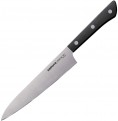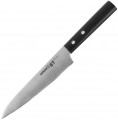Layers number
The number of layers of steel that make up the blade. This parameter is relevant primarily for knives made of Damascus steel (see “Blade material”), however, it can also be indicated for other cases: for example, some knives from traditional Japanese steel grades “shirogami” or “aogami” are made two-layer. However, such models are relatively rare.
As for Damascus, in kitchen knives the number of layers in it can vary from 10 – 13 to 160 – 170. At the same time, there is an opinion that the more layers, the higher the quality of the knife. This is partly true: increasing the "layering" allows you to achieve good strength combined with elasticity, as well as other advanced characteristics. However, note that the actual quality of the blade strongly depends not only on this indicator, but also on many other indicators: the composition of the steels used, the overall quality of processing, technology features, etc. As a result, the number of layers in fact is almost not related to the quality of the blade ; it often happens that in an expensive and advanced model there are fewer layers than in a more affordable analogue. So when choosing, you should first of all focus on the price category of the knife and real reviews about it.
Full tang (increased strength)
Knives for operations and work, in which there are increased loads on the blade and handle. The shank of the blade in their design continues until the end of the handle, usually it has the same thickness as the blade. The handle itself usually consists of two pads, planted on rivets or hidden pins. But there are other versions: with a solid metal or cast polymer handle. In such cases
Full tang knives can be identified by several distinguishing features – a protruding shank at the end, a lanyard hole through which a metal shank is visible, etc.

